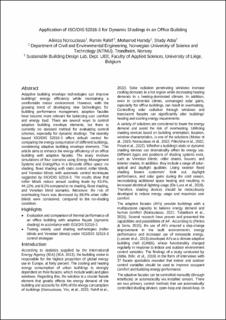| dc.description.abstract | Adaptive building envelope technologies can improve buildings' energy efficiency while maintaining a comfortable indoor environment. However, with the growing trend of developing new technologies for building performance management, adaptive facades have become more relevant for balancing user comfort and energy load. There are several ways to control adaptive building envelope elements, but there is currently no standard method for evaluating control schemes, especially for dynamic shadings. The recently issued ISO/DIS 52016-3 offers default control for comparing the energy consumption of different buildings, considering adaptive building envelope elements. This article aims to enhance the energy efficiency of an office building with adaptive facades. The study involves simulations of four scenarios using Energy Management Systems and EnergyPlus in a Brussels office space: no shading, fixed shading with static control, roller blinds, and Venetian blinds with automatic control techniques suggested by ISO/DIS 52016-3. The results show that roller blinds reduce annual cooling loads by 63.9%, 44.12%, and 8.2% compared to no shading, fixed shading, and Venetian blind scenarios. Moreover, the risk of overheating hours was decreased by 88.9% when roller blinds were considered, compared to the no-shading condition. | en_US |
